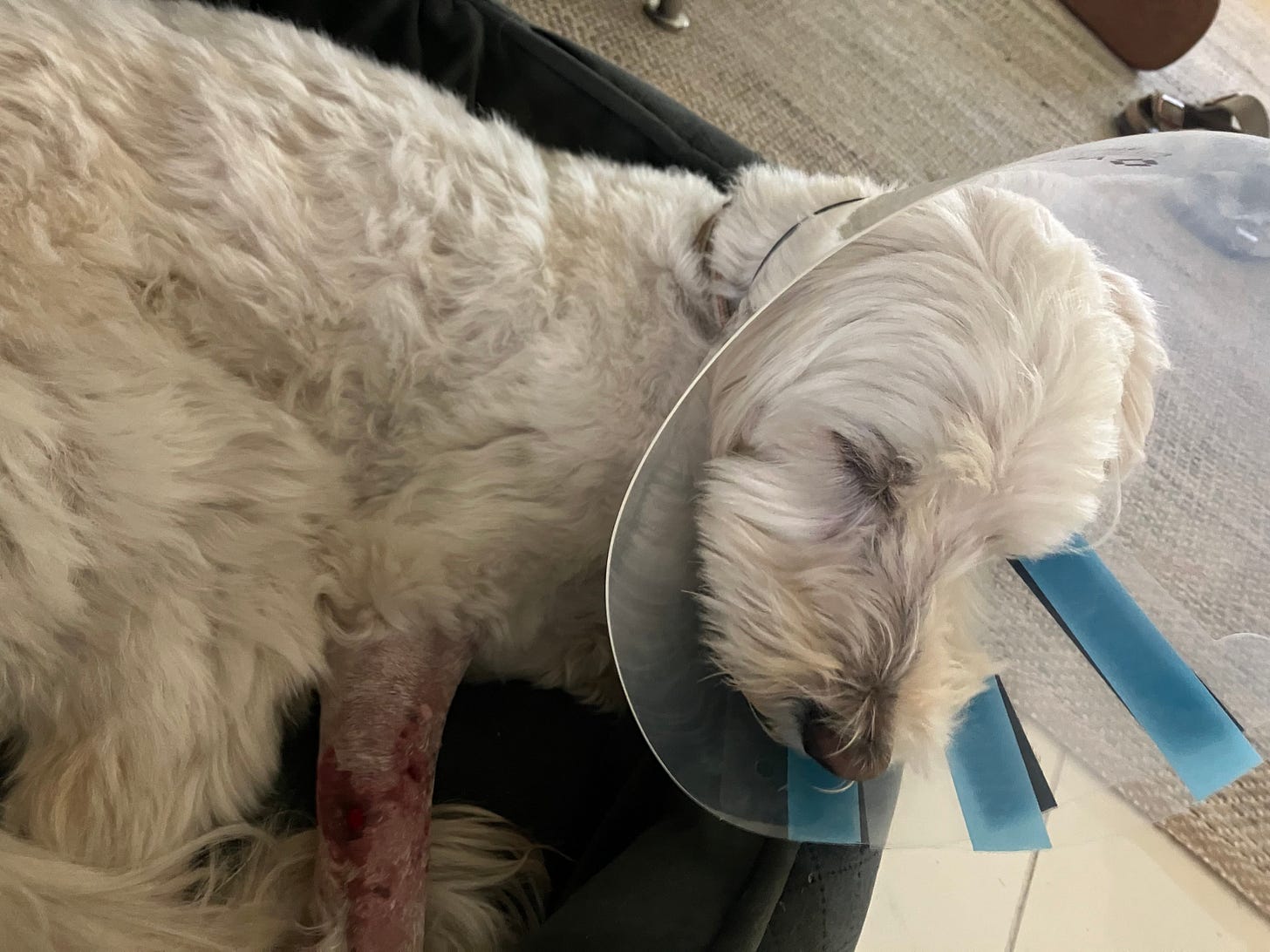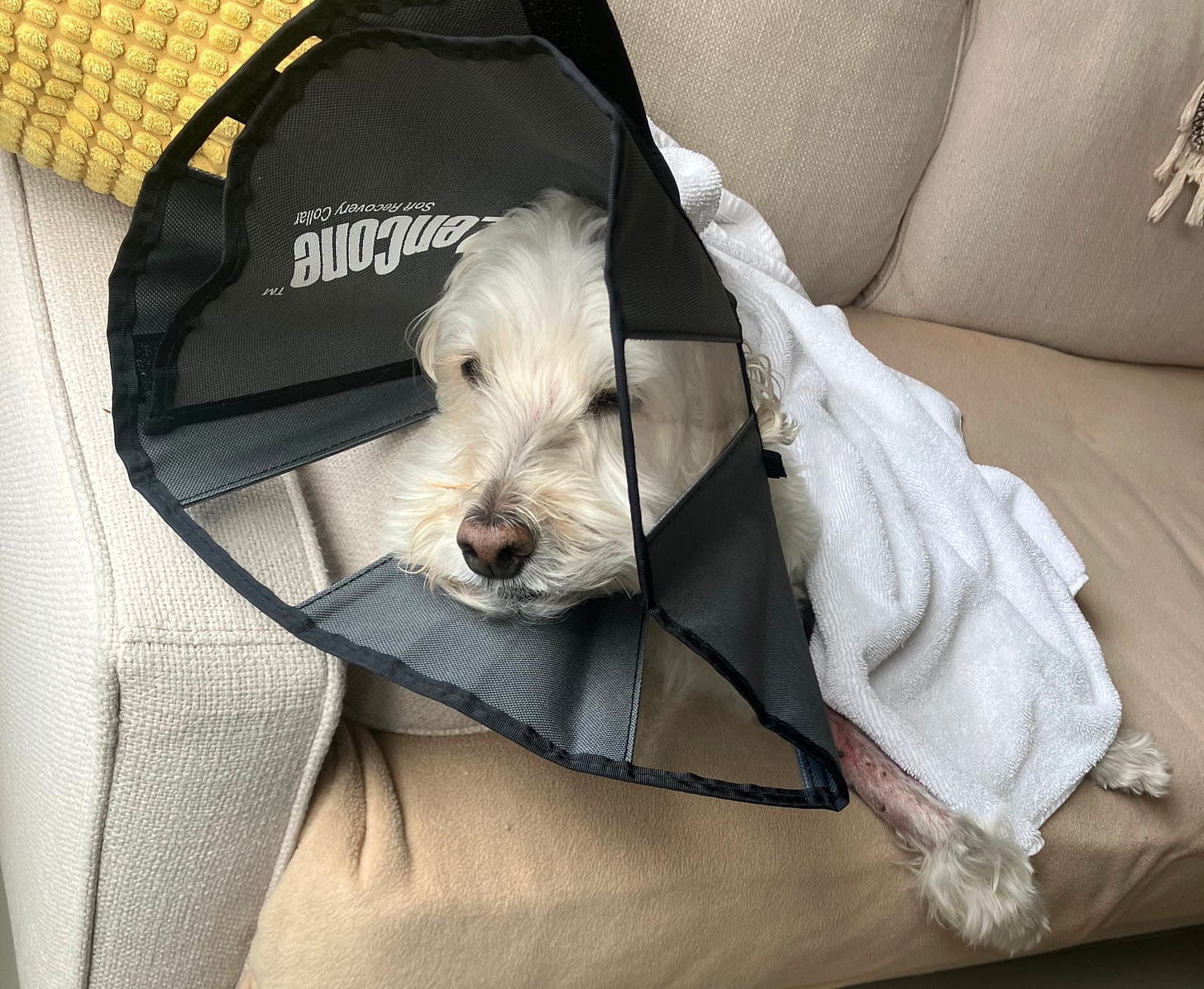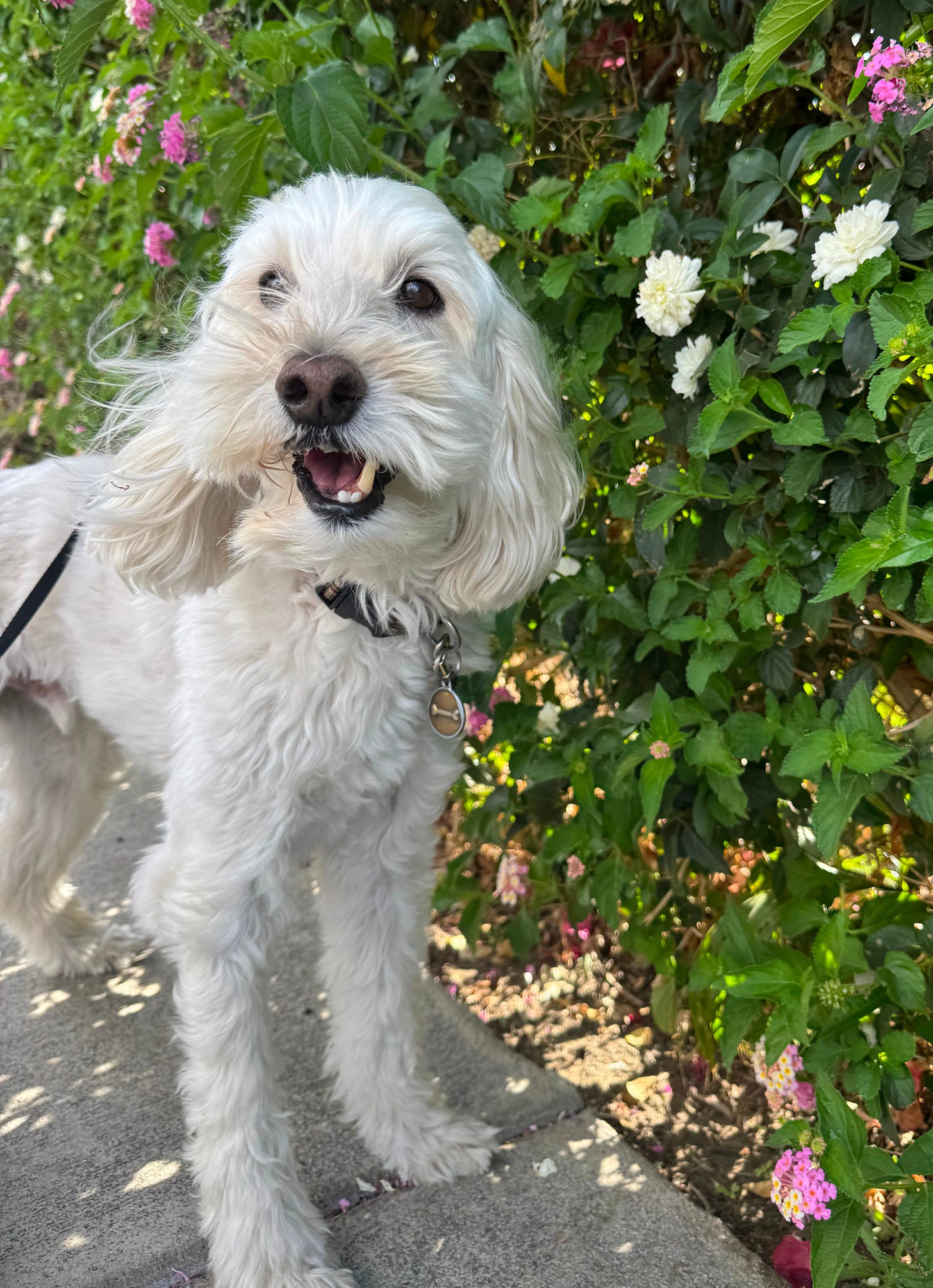Shaking Off Trauma
On "Earthquakes" and Canine Resilience
This winter my mini-labradoodle, Rex, was attacked by an off-leash dog. Mild mannered and 11 years old, sweet Rex and I were on our daily hourlong walk on our usual trail, enjoying the enchanted Palm Springs sun. The mountains, the hummingbirds, the palm trees swaying in the breeze…I attempted to breathe it all in as we strolled at our typical semi-brisk pace. A few yards ahead, an elderly couple had stopped along the trail’s side, taking in the view along with some rays.
In a blink, the couple’s muscular, medium-sized black dog rushed at Rex and pinned him to the ground.
Rex was on his back, yelping and whimpering. Through the cloud of dust arising from the tussle I could see the other dog’s muzzle around Rex’s neck. I dropped to my knees, wringing my hands, a cold weight in my stomach. Somehow the couple managed to pull their beast off, and Rex limped over to me. I saw red—not only from the blood that oozed out of Rex’s right leg, on which he couldn’t put weight, but also from rage. Gently, I pulled Rex into my arms.
“I didn’t hear you coming,” the woman said, as if this were a satisfactory explanation. I was too dumbstruck to reply.
“See if he can walk,” the man said, unhelpfully.
“He can’t!” I yelled. “He’s bleeding! He’s limping and he can’t put weight on it!
“We’ll pay for any vet bills,” the woman said. I’m still not sure which irritated me most: her immediate practicality, her calm demeanor, the fact that she seemed unsurprised, or her earlier excuse. We exchanged phone numbers, and I carried Rex the mile or so home.
My husband Greg and I took Rex right to the vet where they shaved his leg to examine the damage: 8 puncture wounds, all on the same leg. Thankfully he didn’t require stitches. After confirming that he wasn’t injured anywhere else and gingerly applying topical antibiotic ointment, the vet prescribed an oral antibiotic and pain medicine. His assistant presented us with an adjustable recovery cone (a.k.a. “the cone of shame”) to keep Rex from licking his wounds.
Upon returning home I let out a huge sigh of relief. Rex was going to be okay. How he ended up getting there is what captured my attention.
The first couple of days the poor creature could do nothing for himself. We lifted him up on the bed or couch for rest, where we snuggled him in a nest of blankets. We carried him outdoors to relieve himself. I hand fed him and held the water dish up for him to drink. He wanted to be next to me, with a portion of his body touching mine at all times. I cancelled all my commitments so I could provide all that for my most faithful companion. After a few days, when I felt okay leaving him with Greg, I went for a half-hour walk by myself a couple of times a day.
Returning from one such walk, from the bedroom where he had been lying with Rex, Greg said, “There was an earthquake while you were gone.”
My mouth and brow crinkled in puzzlement. “That can’t be,” I said. “I’m sure I would have felt it, too.”
“No,” Greg insisted. “There was definitely an earthquake. I felt the bed shake.”
“I don’t think so—"
We both looked over at Rex, and it seemed to dawn on us at the same time: As he lie there, Rex had been shaking the stress out of his body. There were several more “earthquakes” in the days to come as Rex naturally shook to release stress from his body.
Such behavior is instinctual. To release tension and trauma, animals tremble, shiver, or shake. Releasing excess adrenaline and cortisol, tremoring helps them process and move on from stress. It’s nature’s way of dispersing accumulated fear, a form of somatic release or physiological discharge.
After 10 days, Rex’s wounds were healed enough that the vet gave the okay for the cone to come off. Rex was walking normally. I took him back to our favorite trail. He wasn’t fazed at the site of the incident and showed no fear of people or other dogs. He was back to his usual self.
As a trauma therapist, I found watching this process (and being part of it) fascinating. Rex knew what he needed, and fortunately, we were able to provide it. His humans, of course, took charge of the medical side, which allowed his immune system to do the work of physical healing. Psychologically, instinct ruled. In the days after the attack, Rex let us know he needed extra kindness and nurturing, which consisted of more frequent and closer contact—the reassurance only his family’s immediate physical presence could provide. He allowed us to feed him by hand and carry him to empty his bladder and bowels. He needed assurance he wasn’t alone, that we were there for and with him. He slept even more than usual (thanks in part to the pain medicine and also due to his body’s need to recover), and he allowed himself to obtain it. When stress hormones accumulated in his body, he tremored to release them. The combination of all this allowed Rex to process the trauma and return to his prior level of functioning. This is what I call resilience in action. Such a role model for us humans.
We possess the same capacities, but sadly, people too often are without the resources or get in their own way of naturally processing trauma. We believe we should be able to “power through” difficulties ourselves. We push ourselves to and beyond our limits. We blame ourselves for any trauma that befalls us, even when we are not at fault. We don’t move our bodies enough. When we can’t or don’t attend to our inner trauma processing needs, a long-lasting trauma response results.
On the other hand, when people have a caring other (or group of others) who can support them, reassure them, and help them get trauma out of their system (both physically and psychologically—to the degree those can be separated); when they work through all the thoughts, beliefs, and feelings; when they give themselves time and space to heal; when they know or come to know that they aren’t to blame for the trauma; and when they move their bodies as needed and rest when that’s what their body needs; like Rex, they tend to not develop a long-lasting trauma response.
I’ve seen it in my clients, myself, and now, most naturally and elegantly, with poor Rex.
Rex after his full and complete recovery
* * *
PLEASE NOTE IN THE COMMENTS:
How have you shaken off difficulties? How have you been inspired by others’ stories of resilience following trauma?
* * *
WHAT’S NEXT
MUCH MORE TO COME! I’m in the final stages of completing my next book, on resilience following trauma. In coming Substack posts, I’ll provide previews and share a series of conversations I’ve had with trauma survivors on how they reclaimed their resilience.
* * *
MY CHILDHOOD FRIEND SALLY DUBATS INVITED ME TO BE HER SPECIAL GUEST IN JUNE
“Full Heart Tarot: 8 Keys to a Joyful Life”
June 19, 6:00-8:00 p.m. Pacific Time on Zoom
Sally Dubats is an author and founder of an online Tarot school. She teaches In-Depth Tarot courses from beginning to advanced practices. Sally views the Tarot as a beautiful vehicle to understanding our personal archetypes, and as a gateway to our Highest Selves.
Direct message me for further details.
* * *
REFER A FRIEND: Know someone who could use tips like these? Please forward this post their way. They can click here to subscribe (and get a free workbook to boot!)!
Tom Glaser is a master’s-level licensed psychologist with more than 38 years of professional experience. Following years of childhood trauma, his own journey toward resilience inspired him to specialize in working with trauma survivor clients. As a longtime student and teacher of yoga and meditation, the mind-body connection informs his teaching and psychotherapy practices. He has appeared on more than 100 podcasts promoting happiness and resilience. Tom’s first book, Full Heart Living: Conversations with the Happiest People I Know, was an Amazon bestseller that gave rise to a live performance piece and documentary. He and his husband split their time between Minneapolis and Palm Springs.
FIND OUT MORE here:






So glad that Rex has made a full and complete recovery. Fascinating to hear about his shaking in response to trauma. I experienced this in somatic therapy and in full-body orgasms — frightening, fascinating, and healing at the same time.
Rex is so wise, and a fantastic “co-regulator”. This story reminds me that I can use movement and shaking when I feel that excess adrenaline. 💕